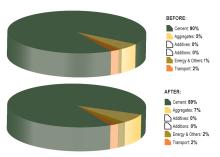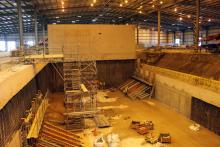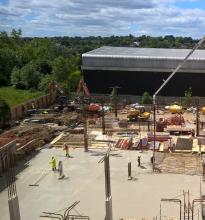
The data from the US-based construction data and analytics provider shows that 81% of structural engineers and 69% of contractors working with concrete are tracking the embodied carbon on their projects, and about one third are already actively reducing it.
Concrete is one of the most carbon-intensive materials used in the construction of buildings. With today’s global advocacy for improving sustainability, Dodge Construction Network says that influencers within the industry are looking to change that.
The Building Sustainably: The Drive to Reduce Embodied Carbon in Concrete Construction SmartMarket Brief, published in partnership with carbon dioxide removal tech company CarbonCure with support from Bio Graphene Solutions, found that building owners are increasingly seeking the reduction of embodied carbon emissions generated during construction and building materials manufacturing.
Further findings include that engineers and contractors are very familiar with the tools needed to track embodied carbon; and advancements in green concrete already exist to support these goals, with use beginning to penetrate the industry.
Building owner preferences are among the most important drivers of change in the construction industry, with 94% of engineers and contractors reporting that clients are requesting reductions of embodied carbon on their projects. The rise in environmental, social and governance (ESG) disclosures on financial ratings have been influential in this development. More than half (56%) of the engineers and contractors report that they work with owners with ESG commitments and nearly three quarters (73%) of them have observed an increase in the number of owners with these commitments in just the past year.
“In all the research we conduct, owner engagement is incredibly important to bring the rest of the industry onboard,” said Donna Laquidara-Carr, industry insights research director at Dodge Construction Network. “Their commitment to reducing embodied carbon is perhaps the most important factor in helping the industry achieve that goal, and we expect those impacts to continue to grow.”
This owner engagement is met by increasing sophistication in the use of the tools needed to address embodied carbon. Environmental product declarations (EPDs) are one of these tools, quantifying the environmental impact of building products. The findings show that nearly all (98%) of engineers and contractors use EPDs on at least some of their projects, and 55% use them on all projects, whenever available. This broad engagement with EPDs is surging: 68% of those using them report that their use increased just in the last year. Driving this trend, 63% of engineers and contractors report that most of their clients ask for EPDs on their projects.
In addition to EPDs, the study also shows that life cycle assessments (LCAs) of projects, which include carbon measurements, are deployed by 78% of engineers and contractors on at least some of their projects. Meanwhile, the use of performance-based specifications, which enables the selection of concrete products based on their carbon content, is on the rise, with 51% of engineers and contractors expecting them to be employed on more projects in the next three years.
“The construction industry’s future will be built on innovation, which is why we’re proud to be a leader in advancing low carbon solutions for concrete,” said CarbonCure Technologies Chair and CEO, Rob Niven. “This vital new research confirms what we’ve seen developing: the unprecedented demand for low embodied carbon concrete products, and for broadly available, robust LCAs. This increasing demand across the private and public sectors is accelerating the transformation of concrete into a global climate solution.”
The report states that tracking a construction project’s embodied carbon through the use of EPDs and LCAs is just the start. The industry also needs viable options for concrete products that involve lower carbon emissions in their production. The study shows that green concrete products already have a foothold in the market. The use of carbon mineralization to reduce cement and associated carbon emissions is already in use by 41% of engineers and contractors. In addition, approaches like admixtures that replace diminishing materials/fly ash or that replace harmful chemicals are also emerging, with concrete products utilizing these approaches specified or purchased by about one quarter of engineers and contractors.










